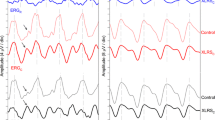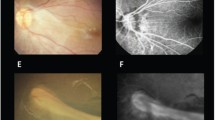Abstract
Electroretinograms (ERG) and electro-oculograms (EOG) were studied in 88 eyes of 44 male patients with X-linked recessive retinoschisis. Differences of fundus appearance, ERG, and EOG between the eyes of each patient were analyzed. Fundus abnormalities were symmetrical in 77.3% of the cases. The amplitude of the ERG a-wave was normal in 26.1% and was abnormally low in 73.9%. The amplitude of the b-wave was below normal in all eyes; thus a small b-wave/a-wave ratio, which is characteristic of X-linked recessive retinoschisis, was observed in every case. The light peak to dark trough (LP/DT) ratio of the EOG was normal in 90.8% of the cases. The relative electrophysiological differences between the two eyes were calculated and showed that a-wave amplitude was not different between eyes in 75.0% of the cases; b-wave amplitude was not different in 77.3% of the cases; b-wave/a-wave ratio was symmetrical in 93.2% of the cases; and the LP/DT ratio was consistent between eyes in 86.8% of the cases. These results suggest that in most cases of X-linked recessive retinoschisis the fundus appearance, ERG, and EOG are similarly affected in both eyes of the patient.
Similar content being viewed by others
References
Arden GB, Barrada A and Kelsey JH (1962a) New clinical test of retinal function based upon the standing potential of the eye. Br J Ophthalmol 46:449–467
Arden GB and Barrada A (1962b) Analysis of the electro-oculograms of a series of normal subjects. Role of the lens in the development of the standing potential. Br J Ophthalmol 46:468–482
Brown KT (1968) The electroretinogram: Its components and their origins. Vision Res 8:633–677
Carr RE and Siegel IM (1982) Visual electrodiagnostic testing: A practical guide for the clinician. Baltimore, Williams & Wilkins, pp 69–71
Denden A (1975) X-chromosomale vitreo-retinale Degeneration ERG- und EOG-Untersuchungsergebnisse. Klin Monatsbl Augenheilkd 166:35–43.
Deutman AF (1971) The hereditary dystrophies of the poterior pole of the eye. Assen, The Netherlands, Van Gorcum, pp 48–99
Forsius H, Eriksson A and Vainio-Mattilla B (1963) Geschlechtsgebundene erebliche Retinoschisis in zwei Familien in Finnland. Klin Monatsbl Augenheilkd 143:806–815
Forsius H, Krause U, Helve J, Vuopala V, Mustonen E, Vainio-Mattile B, Fellman J and Eriksson AW (1973) Visual acuity in 183 cases of X-chromosomal retinoschisis. Can J Ophthalmol 8:385–393
Heilig P and Thaler A (1977). The EOG light peak in X-linked juvenile retinoschisis. Ophthalmol Proc Ser 11, pp 99–103
Hirose T, Wolf E and Hara A (1977) Electrophysiological and psychophysiological studies in congenital retinoschisis of X-linked recessive inheritance. Doc Ophthalmol Proc Ser 13, pp 173–174
Hirose T, Miyake Y and Hara A (1979) Evaluation of severe ocular trauma: Electroretinogram and visual evoked response. In: Ocular trauma: ed: Freeman HM. New York, Appleton-Century-Crofts, pp 31–52
Kraushar MF, Schepens CL, Kaplan JA and Freeman HM (1972) Congenital retinoschisis. In: Contemporary ophthalmology: Honoring Sir Stewart Duke-Elder ed: Bellows JG. Baltimore, Williams & Wilkins, pp 265–290
Krill AE (1977) Krill's hereditary retinal and choroidal diseases. Vol II. Clinical characteristics. Hagerstown, Md., Harper & Row, pp 1043–1062
Manschot WA (1972) Pathology of hereditary juvenile retinoschisis. Arch Ophthalmol 88:131–138
Miyake Y, Miyake S, Yanagida K and Kanda T (1981) X-chromosomal congenital retinoschisis: Its fundus polymorphism and visual function. Acta Soc Ophthalmol Jpn 65:97–112
Odland M (1981) Congenital retinoschisis. Acta Ophthalmol 59:649–658
Ricci A (1960) Clinique et transmission génétique des différentes formes de dégénérescences vitreo-rétiniennes. Ophthalmologica 139:338–343
Schepens CL (1983) Retinal detachment and allied diseases. Vol 2. Philadelphia, WB Saunders, pp 568–588
Thaler A, Heilig P and Slezak H (1973) Elektroretinogramm und Elektrookulogramm bei juveniler Retinoschisis. Klin Monatsbl Augenheilkd 163:699–703
Yanoff M, Rahn EK and Zimmerman LE (1969) Histopathology of juvenile retinoschisis. Arch Ophthalmol 79:49–53
Author information
Authors and Affiliations
Rights and permissions
About this article
Cite this article
Tanino, T., Katsumi, O. & Hirose, T. Electrophysiological similarities between two eyes with X-linked recessive retinoschisis. Doc Ophthalmol 60, 149–161 (1985). https://doi.org/10.1007/BF00158030
Issue Date:
DOI: https://doi.org/10.1007/BF00158030




